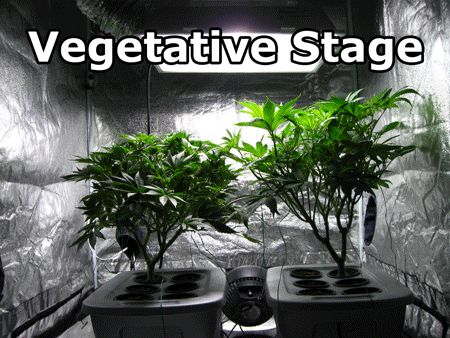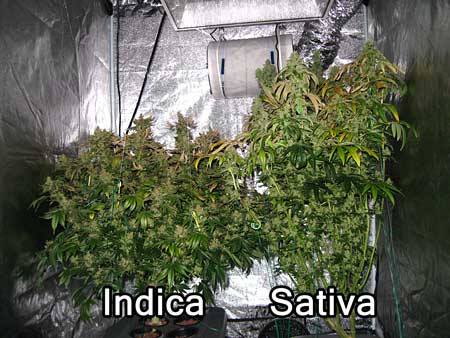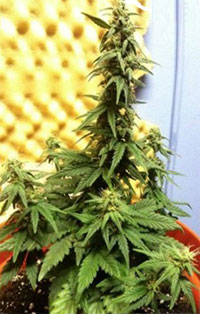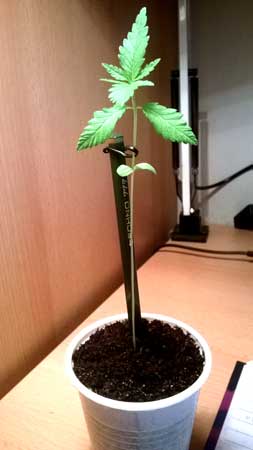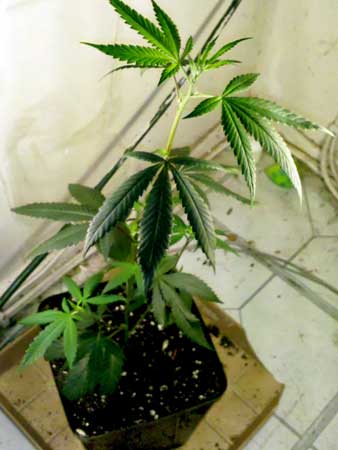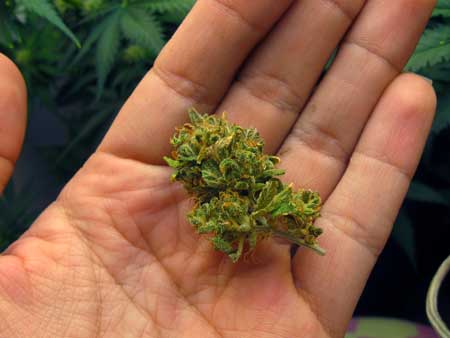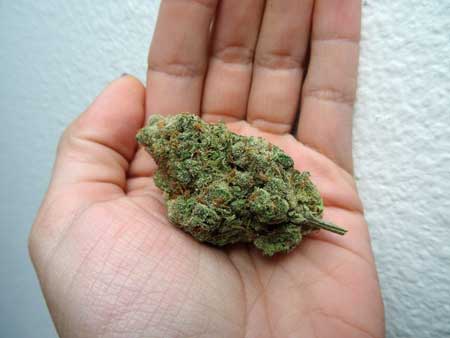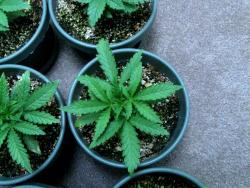by Nebula Haze
Get Set Up For Effective Cannabis Plant Training
- Choose the Right Cannabis Strain
- Indoors: Get the Right Grow Light For Your Space
- Give Roots Room: Choose a Properly Sized Container
This page will help you get ready for the most effective plant training, but here’s the main article on training techniques!
Choose the Right Cannabis Strain
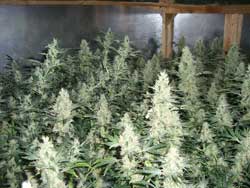
A cannabis plant’s style of growing is greatly affected by its genetics since each marijuana plant tends to grow like its parents.
While different strains show different characteristics, most cannabis plants grow somewhat similarly in the vegetative stage (first stage of life). Strain does have an effect on vegetative growth, for example some plants tend to grow tall, while others tend to grow more squat, but things can get really different when the plants switches from the vegetative stage to the flowering stage.
Oftentimes the tendencies displayed in the vegetative stage become a lot more exaggerated in the flowering stage. If a plant is growing tall and fast in the vegetative stage, that will likely happen even more in the flowering stage.
Some strains grow very tall after being switched to flowering, doubling or tripling their height (or more). Other strains stay short and squat after being switched to flowering, and may not stretch much at all.
A strain that is labeled…
Short – usually stretches less than double the height after the switch to the flowering stage
Average – may double in height after switch to flowering stage
Tall – may double or triple in height after switch to the flowering stage
As you enter flowering, the genetics begin to really show.
Let Me Show You: These plants were grown together. The one of the right starts out a bit taller, and grows just a little lankier than the other one. But generally they’ve stayed about the same height for the vegetative stage. Now look what happens when they get switched over to the flowering stage…
Mismatched Cannabis Strains Are Not As Effective at Using Indoor Grow Lights
Let Me Show You How It Plays Out During the Cannabis Grow
Learn More About How to Prepare for the Flowering Stretch!
What Does Strain Affect?
- vegetative stage growth (but you have a lot of control over how plants grow in veg with the plant training techniques outlined in this tutorial)
- how buds form (density, yields, resin production / stickiness)
- appearance of the buds (color, shape of buds, “sparkliness”)
- final potency – THC levels, CBD levels and more
- taste & especially smell
- time needed until harvest
- nutrient needs (some strains are more sensitive to nutrients than others)
- strengths & weaknesses
- As mentioned before, strain strongly affects he amount plants “stretch” (grow taller) after switching to the flowering/budding stage
Many of these factors can be affected by how you grow your plants, but you’re much more likely to get exactly what you want when you start with the right strain.
Where can I order seeds for the strain I want? https://www.growweedeasy.com/seeds
What about bagseed? Many growers do not have the option to choose a specific strain. First-time growers often use bagseed (seeds they find in their cannabis), and may not know anything about the plant they’re growing. When this happens, it can be hard to predict how the plant will grow in the flowering stage, or the gender, but you can use the techniques on this page to encourage your plant to grow the way you want.
Which strain to start with?
One of the more popularly recommended strains for new growers is…
- Northern Light (low odor, tends to stay short, easy to grow)
I grew Northern Lights for my first grow, and I was very happy with my results. However, I’ve seen first-time growers succeed with many different strains. Of course it’s important to look at the characteristics of the strain and pick one that will be suited to your grow space, but in my opinion the most important thing is to choose a strain you want.
Most Importantly, Choose a Strain That Excites You!
Whether you want to grow a famous strain, try something new, or pick a strain for your medical marijuana needs, you’ll be able to find what you’re looking for when buying cannabis seeds online.
There are two main types of cannabis, photoperiod (most plants) and auto-flowering.
Learn more about the difference between “regular” (photoperiod) and auto-flowering strains
Photoperiod (Most Strains Are Photoperiod Strains)
Nearly all cannabis strains are photoperiod and need 12-12 lighting to make buds. If you don’t know what type of seed you’re starting with, it is almost always a photoperiod strain.
- Photoperiod strains give you the power to decide when they start budding, which gives growers more control over how plants grow
- More strains to choose from
- Growers can use all plant training techniques on photoperiod plants
- Photoperiod plants can be cloned: https://www.growweedeasy.com/cloning
- Photoperiod strains tend to get bigger yields that autos (but not always)
- Need a light proof space with no light leaks – Photoperiod strains need a 12-12 light schedule to make buds, and growers usually use a timer and ensure plants get 12 hours of complete darkness every night during the flowering stage (usually accomplished with a grow tent or grow box). Without complete darkness at night the plants won’t start making buds.
Unless a grower specifically says their plant is an “auto-flowering” plant, you can assume they’re talking about a photoperiod cannabis strain.
Auto-flowering
Strains that are auto-flowering automatically start making buds after a few weeks, regardless of light schedule.
- Less strains to choose from, though autos from trustworthy breeders produce buds with similar effects to photoperiod strains
- Plants start making buds in about 3 weeks, and most are ready to harvest in about 3 months
- Not as many training options – only gentle plant training techniques are okay for auto-flowering strains; no topping, FIMing or main-lining for autos. In other words, you have less control over the final size/shape of the plant compared to photoperiod strains
- Cannot be cloned – auto clones are the same age as the mother plant and will die off when she does; this means you need to keep getting new seeds to grow auto-flowering plants.
- No need to worry about light schedules or light leaks – autos don’t really respond to light schedules.
- Autos tend to stay small (which is convenient if that’s what you want, but can also translate to lower yields). However sometimes you’ll see autos labeled “XXL” or “Monster” and things that sound like that. A lot of these types of autos will grow much bigger and take longer to mature than your standard auto. Try to read the description of each strain and order from a trusted autoflowering breeder to make sure you get what you’re looking for!
Auto-flowering strains are popular for indoor growers who cannot light-proof their grow area, or do not want to worry about light schedules. Autos can also be useful for outdoor growers who are normally dependent on the seasons to determine harvest time. For example, if I have warm weather for at least 3 months, I can grow an auto even if the sun time schedules don’t match up (generally photoperiod cannabis plants aren’t ready to harvest until late fall). That means I could grow autos all year round in a warm climate, or in a place with a very short warm season.
Make sure you always buy seeds from a reputable breeder!
More about Photoperoid vs Auto-flowering
https://www.growweedeasy.com/autoflowering-vs-photoperiod
Indoors: Get the Right Grow Light For Your Space
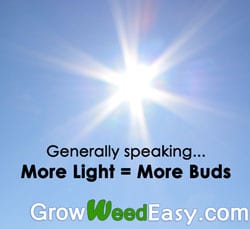
Basically…
More Light = Bigger Yields
Of course this isn’t true in all cases, but cannabis plants need a lot of light.
Can You Provide Too Much Light?
Yes, there is a point when you can provide too much light to your plants (causing light burn, bleaching and other problems), but most indoor growers won’t hit that point unless they keep lights too close to the plants.
Get a breakdown of the most popular types of cannabis grow lights
(setup cost, electricity cost, what yields to expect, and more!)
Outdoor growers it’s difficult to give plants too much sun. They just need to make sure they don’t increase the amount of light too fast (don’t move an indoor plant into direct sunlight without giving the plant some time to adjust). But once a cannabis plant is used to being outdoors, it likes 8+ hours of direct sunlight every day for best growth and biggest yields.
For indoor growers, one of the first things you want to do is ensure that the plant is getting the right amount of light. It’s common for new indoor growers, especially those on a budget, to not provide enough light for their cannabis plants.
What Happens When Cannabis Doesn’t Get Enough Light?
During the vegetative stage, cannabis plants which don’t get enough light are slow growing and tend to ‘stretch’ up toward the light with a lot of space between nodes or “branches.” This is not usually a good thing, because tall lanky plants are hard to give proper light coverage in flowering, and may not be able to hold themselves up without support. Additionally, you can only grow buds where the leaves hit the stem, so if you have a lot of stem with no leaves, it also means you don’t have many places where bud can grow.
Not enough light in the vegetative stage
(stretchy, tall growth, very few bud sites)
Once cannabis plants are in the flowering stage, light intensity is what directly drives the production of buds. Cannabis plants can use more light in the flowering stage than in veg. Not providing enough light will result in smaller, airy buds and lower yields. Even with low light, it’s common for growers to have really healthy plants all through the vegetative stage, but in the flowering stage the plant won’t produce much bud, even if it stays healthy.
For best results, you want all your buds directly exposed to strong light. This causes buds to swell up much more than when the buds are hidden from the light. In the wild, cannabis plants are pollinated by the wind, so it makes sense that the buds that are exposed to wind and light tend to get bigger (buds hidden in the inside of the plant are unlikely to fill out or get dense).
Buds not getting enough light in the flowering stage
Not enough light in the flowering stage results in undersized, fluffy buds with little density.
Getting enough light in the flowering stage
The only way to get big, dense buds is giving plants a lot of intense light in the flowering stage
Learn about different grow lights that work for growing cannabis
Get the Right Sized Container or Pot for Your Cannabis
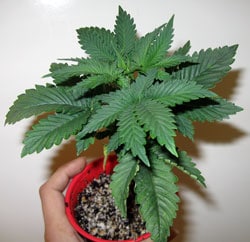
Hydroponic growers can often get away with smaller containers for their roots than soil growers because they provide nutrients directly to the plant roots in their water (plant roots don’t need to seek out nutrients like they do in containers). Learn more about growing in Soil vs Hydro
Smaller pots tend to keep plants smaller, but too small containers can trigger problems because roots wrap around the edges of the container and “choke” themselves, a state known as the plant being rootbound.
What are the different types of containers for growing cannabis?
(some containers like air pots and smart pots can prevent plants from becoming rootbound)
If your plant is rootbound, it becomes more and more prone to drooping and nutrient deficiencies, especially if it’s kept in a very small container. The roots just aren’t able to do their job properly.
The plant my be fine at first, but as time goes on, it will become harder and harder to keep a root-bound plant healthy and eventually you will need to transplant to get plants to start growing fast and vigorously again.
Choose a Container (general guide)
Your final desired plant size is…
12″ tall plant ~ 2-3 gallon container
24″ tall plant ~ 3-5 gallon container
36″ tall plant ~ 5-7 gallon container
48″ tall plant ~ 6-10 gallon container
60″ tall plant ~ 8-10+ gallon container
Can I Use a Small Container to Force Plants to Stay Small?
Some growers choose to use the power of smaller containers to force plants to stay small on purpose, but the problem with that is in addition to staying small the plant can become rootbound and unhealthy.
Also, when your cannabis is kept in a smaller container, you will notice that you have to water your plant much more often than if you kept your plant in a big pot.
How often should I water my cannabis plants?
I never recommend growing cannabis in a container that is smaller than 2 gallons, such as the ones pictured here, and most growers will be happier with one that is bigger.
There are many powerful growth control techniques on this page that allow you to grow high-yielding plants while keeping them short, so there is no need to grow in a too-small container and risk dealing with root problems!
Continue to the Main Plant Training Article!
Jump to…
What grow lights should I get?
10-Step Quick Start Grow Guide
Should I get a regular or autoflowering strain if I want short plants?
Picture gallery of common marijuana growing problems

